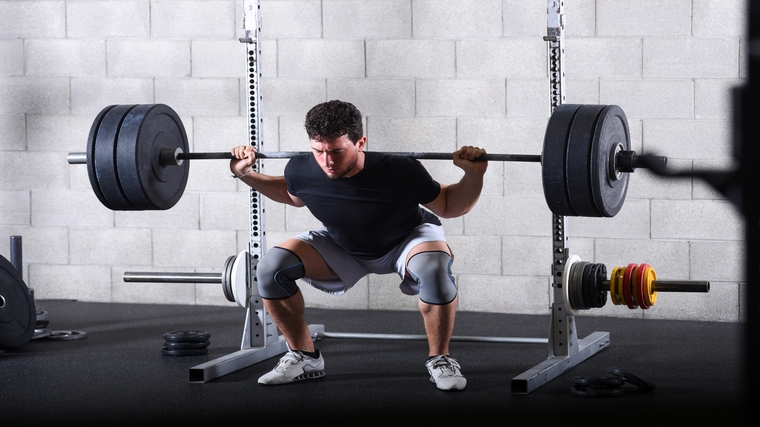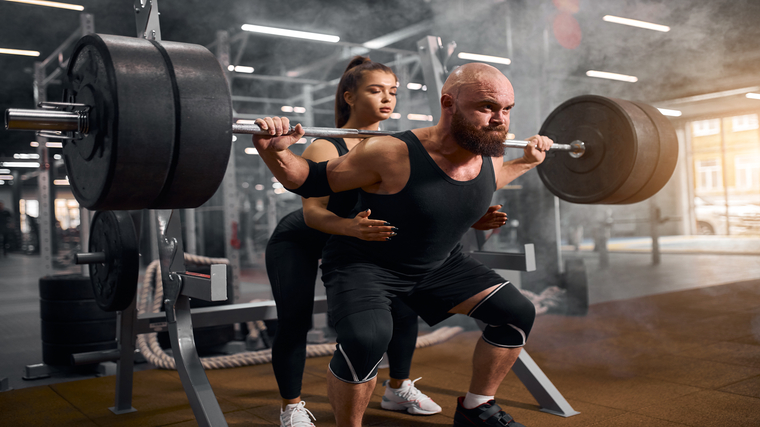Whether you’re a competitive athlete or a recreational lifter looking for a boost in your squat, you’ve probably seen someone roll up to the squat rack with compression sleeves on their knees. For most, knee sleeves are used as an additional layer of protection for your knee joints. Deep squatting isn’t necessarily bad for your knees, but that doesn’t mean years of hoisting heavy barbells doesn’t take a toll.
Protection isn’t the only reason that lifters from CrossFit to strongman slide on knee sleeves before competition. Strength training lore has it that knee sleeves can increase your squat max — but can they?

The idea is that wearing knee sleeves compresses your joints enough to help give you a slight rebound out of the hole of your squat. This little rebound can also help you gauge your level of depth before standing up. For many athletes, their sticking point is slightly above parallel, so having this slight block to provide an extra boost of rebound at the bottom can create a bit more speed out of the hole. Does this little rebound add up to a heavier squat? Here’s what the research says.
- What Are Knee Sleeves?
- Knee Sleeves Vs. Knee Wraps
- Potential Benefits of Squatting in Knee Sleeves
- Potential Drawbacks of Squatting in Knee Sleeves
- Who Should Squat in Knee Sleeves
- When to Squat in Knee Sleeves
Editor’s note: The content on BarBend is meant to be informative in nature, but it shouldn’t take the place of advice and/or supervision from a medical professional. The opinions and articles on this site are not intended for use as diagnosis, prevention, and/or treatment of health problems. Speak with your physician if you have any concerns.
What Are Knee Sleeves?
Knee sleeves are neoprene covers for your knees that are designed to slide up your lower legs, compressing your knees and surrounding muscles. They’re typically available in lengths of 20 or 30 millimeters, with thicknesses generally ranging from three to seven millimeters.
Why bother? The goal of wearing knee sleeves is to help stabilize your knees during heavy lifts and possibly boost your performance. Even though they’re often worn very tight — compression is the point, after all — knee sleeves aren’t supposed to disrupt your normal range of motion.
[Related: SBD Vs. Slingshot STrong Knee Sleeves — Which Is Best For Squats?]
Knee Sleeves Vs. Knee Wraps
Knee sleeves are not the same as knee wraps. Knee sleeves are generally more versatile than knee wraps since you can wear sleeves throughout your workout. On the other hand, knee wraps are spiraled around your knees to provide maximum tightness. Wrapping your knees over and over again is a much bulkier process than sliding on less than seven millimeters of fabric. For this reason, knee wraps run the risk of disrupting your form. (1)
However, knee wraps can significantly boost your squat numbers. Wrapped squats are often significantly heavier than sleeved squats. So if you’re very experienced and breaking them out for your heaviest lifts, wraps might be the way to go for those extra pounds in competition.
Potential Benefits of Squatting in Knee Sleeves
Training yourself to squat heavier isn’t just a matter of whipping out the newest gear. But that doesn’t mean some well-placed, strategically-used equipment can’t be helpful.
Squat Heavier
Knee sleeves may not be able to give you an instant 50-pound boost to your squat max — if only — but that doesn’t mean they’re not at all helpful. Neoprene sleeves do seem to marginally improve squat one-rep maxes, even though they don’t seem to impact squat jumps, leg extensions, or leg presses. (2)(3)
Improve Perceived Stability
Wearing knee sleeves can increase a lifter’s perceived knee stability. (4) This might be significant when lifters are building barbell confidence under progressively heavier loads. If you’ve ever tried to squat heavy and you felt unstable the moment you unracked, the safety blanket of knee sleeves might help you feel a bit more steady.
Boost Squatting Confidence
Knee sleeves might also improve your proprioception — your accurate awareness of your body in space. (5) Having better awareness of how your body is moving might help you gain confidence in the hole.

You might also gain a better understanding of how to cue yourself back to standing under a heavy load. This is especially important for powerlifters who need to boost their max squat — the better lifters can accelerate out of the hole, the more squat strength they seem to have. (6)
Potential Drawbacks of Squatting in Knee Sleeves
If you’re competing, check — and double and triple check — that all your gear, including your knee sleeves, is up to snuff and allowed in your meet. There are few things worse than showing up to compete after training with equipment you won’t be permitted to use. But that’s not the only potential drawback of knee sleeves.
Unintentional Overreaching
Wearing knee sleeves can lead to a breakdown in form if they’re giving you the false confidence to go too heavy, too fast. While barbell confidence is a must, overconfidence might set you up for injury. Make sure you’re programming gradual progressions of weight increases into your program so that you’re not suddenly finding yourself under a weight your body can’t handle.
Tighter Isn’t Necessarily Better
If you wear your knee sleeves super tight, you might be going through all that strain for nothing. For lifters who shimmy themselves into a knee sleeve that’s one size too small, research suggests that tighter may not mean better.
For athletes who are experienced in resistance training but new to wearing knee sleeves, neoprene sleeves might help boost a one-rep max squat a little bit. But wearing a tighter sleeve doesn’t necessarily produce a bigger effect than regularly-sized sleeves. (2)
Who Should Squat in Knee Sleeves?
Knee sleeves might seem like a must-have, but they’re not necessarily for everyone. Unless you’re into intense strongman training or powerlifting, you probably don’t have cause to slide into them on the regular. Here are some athletes that can benefit most from knee sleeves.
Competitive Strength Athletes
Different powerlifting federations (and divisions within federations) allow different kinds of gear. This differs, too, from sport-to-sport. Make sure to clarify with your federation whether your knee sleeves are permitted in your division.
- Powerlifters: Check out your federation’s rulebook to clarify what kinds of equipment are allowed. When you’re allowed to use knee sleeves in a USA Powerlifting meet, for example, they must be made of single-ply neoprene, and they’re not allowed to be thicker than seven millimeters.
- Strongman and Strongwoman Athletes: With the exception of squat suits (which are competition-dependent), supportive gear — including knee sleeves — are permitted in competition. But since they may take emphasis off your quads to some extent, you might want to avoid them in more endurance-based events. Otherwise, your hamstrings may have to kick in for compensation.
- CrossFitters: Athletes are typically allowed to — and often do — wear knee sleeves during CrossFit competition.
As a general rule of thumb, consider avoiding equipment that your federation or division doesn’t allow. That way, you won’t get used to something in training that you can’t use in competition.
Experienced Strength Athletes
You don’t have to compete to benefit from wearing knee sleeves. You may want to squat as heavy as you can regardless of whether you have any desire to compete. In that case, you might want to use knee sleeves in your own gym.
Before you try knee sleeves, make sure your form is solid under heavy loads. Build a firm foundation of strength. Consider only shimmying into them when you’re going all-out and heavy in the gym. You might also want to use them for high-volume session.
When to Squat in Knee Sleeves
Knee wraps are meant to be so tight that you can really only wear them during your actual squat attempt. That’s not the case with knee sleeves. Once you tug them on, they won’t restrict your movement all that much. Since that’s the case, many athletes wear them throughout a training session to keep their knees warm and ready to go.
But does that mean you should wear them during every session? Unless your sessions are all extremely hard and heavy, then you probably don’t have to. In general, you’ll want to pull on your knee sleeves when you’re either going very heavy or for very high volume. That might mean attempting a new max squat number. It might also mean gearing up — literally — for a 20-rep squat session.
Sleeves On
Let’s call it like it is. Knee sleeves alone won’t increase your squat by a huge margin. Multiple factors — like baseline strength and experience level — need to align to provide a significant physical increase.
Still, you might want extra support and the added confidence that can come with it. In that case, knee sleeves can indirectly help bolster your squat performance — and make you feel more stable.
References
- Lake JP, Carden PJ, Shorter KA. Wearing knee wraps affects mechanical output and performance characteristics of back squat exercise. J Strength Cond Res. 2012 Oct;26(10):2844-9.
- Machek SB, Cardaci TD, Wilburn DT, Cholewinski MC, Latt SL, Harris DR, Willoughby DS. Neoprene Knee Sleeves of Varying Tightness Augment Barbell Squat One Repetition Maximum Performance Without Improving Other Indices of Muscular Strength, Power, or Endurance. J Strength Cond Res. 2021 Feb 1;35(Suppl 1):S6-S15.
- Hatfield DL, Stranieri AM, Vincent LM, Earp JE. Effect of a Neoprene Knee Sleeve on Performance and Muscle Activity in Men and Women During High-Intensity, High-Volume Resistance Training. J Strength Cond Res. 2021 Dec 1;35(12):3300-3307.
- Sinclair, J., Mann, J., Weston, G., Poulsen, N., Edmundson, C. J., Bentley, I., & Stone, M. (2020). Acute effects of knee wraps/sleeve on kinetics, kinematics and muscle forces during the barbell back squat. Sport Sciences for Health, 16(2), 227-237.
- Herrington L, Simmonds C, Hatcher J. The effect of a neoprene sleeve on knee joint position sense. Res Sports Med. 2005 Jan-Mar;13(1):37-46.
- Miletello WM, Beam JR, Cooper ZC. A biomechanical analysis of the squat between competitive collegiate, competitive high school, and novice powerlifters. J Strength Cond Res. 2009 Aug;23(5):1611-7.
- Gomes WA, Brown LE, Soares EG, da Silva JJ, de O Silva FH, Serpa ÉP, Corrêa DA, Vilela Junior Gde B, Lopes CR, Marchetti PH. Kinematic and sEMG Analysis of the Back Squat at Different Intensities With and Without Knee Wraps. J Strength Cond Res. 2015 Sep;29(9):2482-7.
Featured Image: Photology1971 / Shutterstock